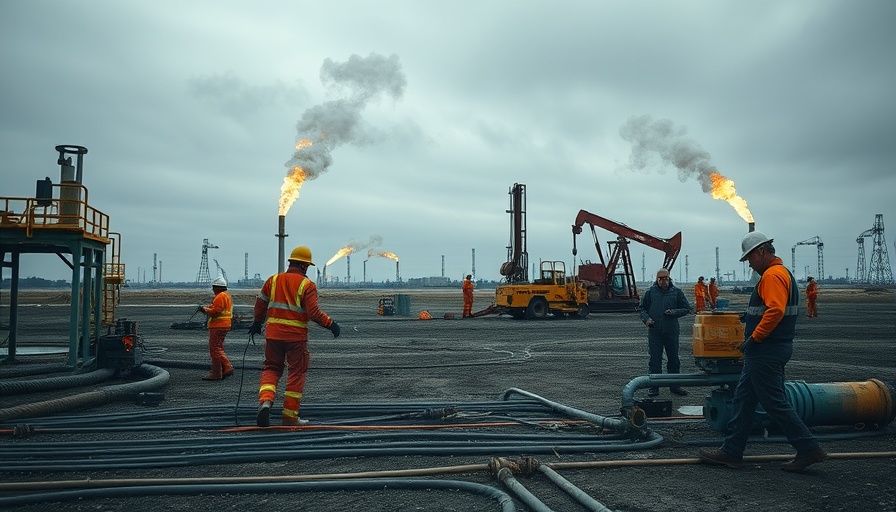
Mercuria Invests in the M'Boundi Oil Field – What This Means for Congo
The M'Boundi oil field in Congo has garnered significant attention following the financial backing it received from Mercuria, the renowned Geneva-based energy trader. This investment not only marks a pivotal moment for the national oil company, SNPC, but also signifies a broader engagement in the Congolese energy landscape, previously dominated by major players like ENI. By providing the necessary funds to acquire ENI's stake in the oil field, Mercuria is stepping into the shoes of a traditional oil player, indicating a shift in investment strategies as the global energy sector evolves.
The implications of this investment stretch beyond immediate financial assistance. It has the potential to reshape governance, energy independence, and economic growth within the region, reflecting the complexities of investment dynamics in volatile environments. Mercuria's involvement signals a strategic pivot towards enhancing local capacities amidst Congo's ongoing narrative of economic development and reforms.
Erroring Towards Opportunity – Governance Through Energy
Congo’s hydrocarbon sector has long been marred by governance challenges ranging from corruption to inefficient asset management. However, the backing from Mercuria brings a glimmer of hope for improving operational standards and enhancing transparency. Understanding the foundation of these changes is crucial—will this partnership lead to sustainable governance practices or simply bolster existing inequalities?
Furthermore, the entrance of Mercuria into the M'Boundi oil field is not just about extracting profits; it may serve as an avenue for fostering international standards of corporate governance. Improved practices can have a ripple effect, influencing local laws and potentially increasing investor confidence in Congo. This situation emphasizes the need for accountability, signaling that foreign investments can indeed promote better governance when managed appropriately.
Energy Security and Economic Growth – A Dual Major Goal
Energy security remains an ongoing concern, especially for countries like Congo that rely heavily on oil exports. Mercuria's investment can enhance the country’s energy stability, allowing it to meet both local demand and secure foreign revenue streams. This not only reinforces Congo's position in the global energy market but also enhances its self-sufficiency.
Moreover, energy independence can contribute to broader economic development. With significant investments flowing into the M'Boundi oil field, there is potential for job creation, technological enhancements, and infrastructure development. Such advancements may provide the groundwork for diversifying the economy away from traditional sectors, further stimulating growth.
Decolonization of Energy Investments: A Pan-African Perspective
In the broader context of Africa, Mercuria's backing could signify a shift towards decolonizing energy investments. Traditionally, western companies have dominated Africa's natural resources, often leading to exploitative practices and minimal local benefit. This new wave of investment from Mercuria can be interpreted through the lens of Afrocentrism, aiming to not just extract resources but to engage meaningfully with local economies.
This approach aligns with the principles of the African Continental Free Trade Area (AfCFTA), which encourages intra-African trade and investment. As Mercuria navigates the complexities of the Congolese oil market, its potential commitment to local development initiatives could set a precedent for future investments across the continent.
Challenges and Opportunities for Sustainability
While the investment holds potential, it does not come without challenges. Incorporating sustainability practices in local operations remains critical. The Congolese government, alongside Mercuria, must address the environmental impact of oil extraction, especially in a country where biodiversity is already under threat. This partnership may serve as an opportunity to invest in renewable energy alternatives, thus contributing to the global narrative of climate change mitigation.
A Call for Inclusive Stakeholder Engagement
For the partnership to yield long-term benefits, inclusive stakeholder engagement is essential. This means involving local communities and ensuring that the benefits of the M'Boundi oil field translate into tangible development outcomes for the Congolese people. As we move forward, creating frameworks that prioritize human rights and community engagement will be paramount.
Congo stands at a crucial crossroads with Mercuria’s involvement in the M'Boundi oil field. As these developments unfold, professionals, policy-makers, and local communities must align their efforts to foster a sustainable, accountable, and inclusive energy sector.
Given the complex interplay between governance, economic growth, and energy security, it’s essential to stay informed and engaged. As stakeholders, we must advocate for greater transparency and accountability in these investments, ensuring that they lead not only to higher profits but also to an empowered local populace.
 Add Row
Add Row  Add
Add 




Write A Comment